The Fine Art Group is proud to announce the opening of a new regional office in historic Charleston, S.C., allowing our experienced team of appraisers and advisors to maintain the highest levels of accessibility, transparency and trust for clients in the southeastern United States.
Since its founding in 1670, Charleston has remained a cultural crossroads and retained an extended dialogue with the fine and decorative arts market driving connoisseurship and collecting throughout the region.
TFAG looks forward to taking part in this important conversation by providing clients with the same access to exceptional art market intelligence they have grown to know and expect. Our services include appraisals, visual inventory, collection management, art advisory and continuing education. Details on these services are at our service page.
Shane David Hall, Appraiser & Advisor – Senior Decorative Arts Specialist, will lead the Charleston location. Shane earned Bachelor of Fine Arts degrees in Historic Preservation, Urban Planning and Art History from the College of Charleston, and a Master of Arts in American Fine and Decorative Arts from Sotheby’s Institute of Art, New York City.
With a lifelong enthusiasm for art, architecture and decorative arts, Shane began his career as curatorial assistant at This Historic Charleston Foundation and interned with the prestigious Winter Show. He acquired extensive art market experience at three international auction houses, becoming the Director of Selkirk Auctioneers & Appraisers in St. Louis, Mo. , one of America’s oldest auction firms. Shane is certified in the Uniform Standards of Professional Appraisal Practice and is an active member of the College of Charleston Alumni Association. Hall looks forward to assisting clients in North Carolina, South Carolina, Georgia, Alabama, Mississippi, Louisiana, Texas and beyond.
SHANE’S INSIDER GUIDE TO CHARLESTON
MUSEUMS
Gibbes Museum of Art
Founded in 1858, the Gibbes Museum is the foremost collection of American art that incorporates the story of Charleston and the South. The museum connects the city and regions artistic past to a vibrant contemporary art scene and continued scholarship.
Halsey Institute of Contemporary Art
Housed within the School of the Arts at the College of Charleston, the Halsey originates five to seven exhibitions annually dedicated to contemporary art and focusing on emerging and mid-career artists.
EVENTS
Charleston Antiques Show
The premier fine art and antiques show in the southeast highlighting over 30 dealers of fine arts and antiques showcasing 17th to mid-century modern, English, European and American period furnishings, decorative arts and fine art, architectural elements, garden furniture, vintage jewelry, silver and more.
Spoletto USA
For 17 days and nights each spring, Spoletto Festival USA fills Charleston’s historic theaters, churches and outdoor spaces with performances by renowned and emerging artists in opera; theater; dance; and chamber, symphonic, choral, and jazz music. Spoleto Festival USA is recognized as America’s premier preforming arts festival.
DINING
Breakfast
Miller’s All Day
Celebrating everybody’s favorite meal by shining a spotlight on small batch grains, perfectly turned eggs, delicious proteins, craft cocktails, and gentle surprises designed to delight even the most hardboiled diner.
Lunch
Gaulart & Maliclet
Providing fresh, affordable, healthy, global cuisine with French flair in a social environment that encourages community and the Arts.
Dinner
FIG
Our approach is simple. We have a passion for pure flavor, quality ingredients, and for creating an atmosphere that is convivial, approachable, and a haven for people who simply love food.
WHAT ARE THE “BLUE CHIP” AREAS OF NUMISMATIC COLLECTIONS?
The financial world and the art world effortlessly intersect when it comes to investments in valuable works by “Blue Chip Artists.” “Blue Chip” is a term that originated in finance to describe large and established companies whose stocks have a solid current value and dependable financial future. In the art world, the term has been applied to certain artists who had an established and successful career and predictable, strong and appreciating values for their works on the secondary market. Rothko and Picasso are core examples, where their works are acquired as investments and appreciating tangible assets.
The spotlight is often on significant and recognizable artists of the Modern and Contemporary art market, with both the art world and financial world tracking their sale results and new world records at Sotheby’s and Christies annually. However, quietly and without fanfare, there are incredibly impressive markets for other tangible assets. This includes rare and collectible coins, for which the market of sales and acquisitions surpassed a staggering $4 billion in 2018 alone. Other categories include rare and historical manuscripts, collectible cars and luxury time pieces.
What are the “Blue Chip” areas of numismatic collections? Blue Chip coins, like stocks, are examples that have demonstrated long-term investment security and growth. For coins with numismatic value, which have value surpassing their intrinsic or material value, value is often tied to rarity and grade.

Some of the areas in numismatics which are considered blue chip due to their appeal to serious collectors and a strong and steady value appreciation are the following:
EARLY GOLD
“Early Gold” refers to any gold U.S. coins minted between 1795 and 1839. The first gold coins were introduced in three denominations: the $10 eagle, $5 half eagle and $2.50 quarter eagle. The denominations weren’t printed on the coins, but value was based on its weight, with the $10 eagle being equal to ten silver dollars. These early United States gold coins are coveted by collectors and investors for their historical importance, rarity and value. The most coveted and valuable are high-grade uncirculated examples that can sell into the millions of dollars. One of the most valuable coins in this group is the finest example of the 1795 Draped Bust Gold Eagle which had a mintage of 5,583 coins. However, experts suspect that only 10% of these coins survived. The finest example, part of the D. Brent Pogue Collection, sold for just over $2.5 million in 2015 at Stacks Bowers.
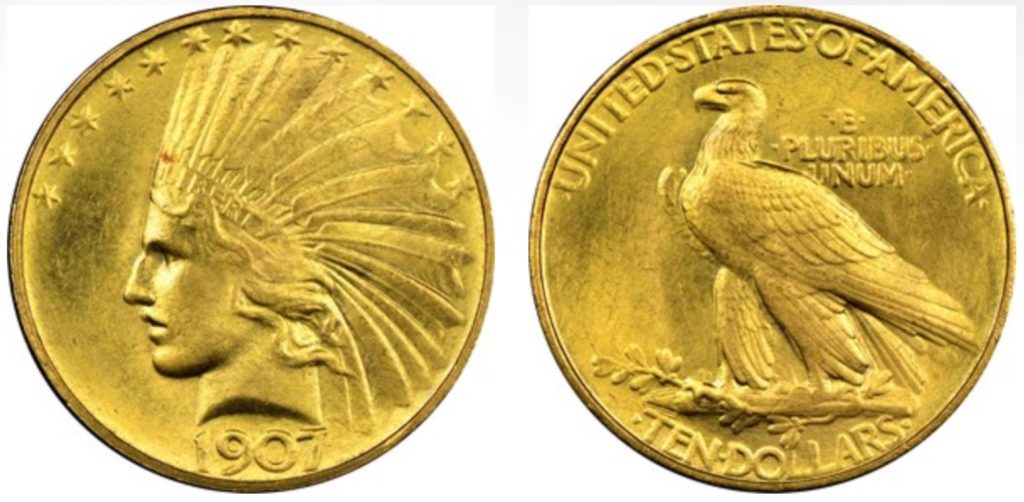
KEY DATES
Coins are produced in certain quantities or mintages each year, with certain dates or particular mint locations being scarcer than others due to only a small number of coins either being minted or a change in production resulting in the original mintage being melted, with only a select few being retained. For U.S. coins, the particular coins produced in a certain year where the mintage or surviving coins is small are referred to as “Key Dates.” These particular coins are some of the rarest in the numismatic world. They tend to sustain and appreciate in value as they are always sought after by serious collectors and investors who have a need to complete a collection. One of the most valuable of these key date coins is 1907 rolled edge Indian $10, which has doubled in value over the last 20 years, consistently selling close to $200,000. The value is due to the original mintage of 31,500 coins being held back before release and melted down. It is suspected under 50 coins were retained for archival purposes.
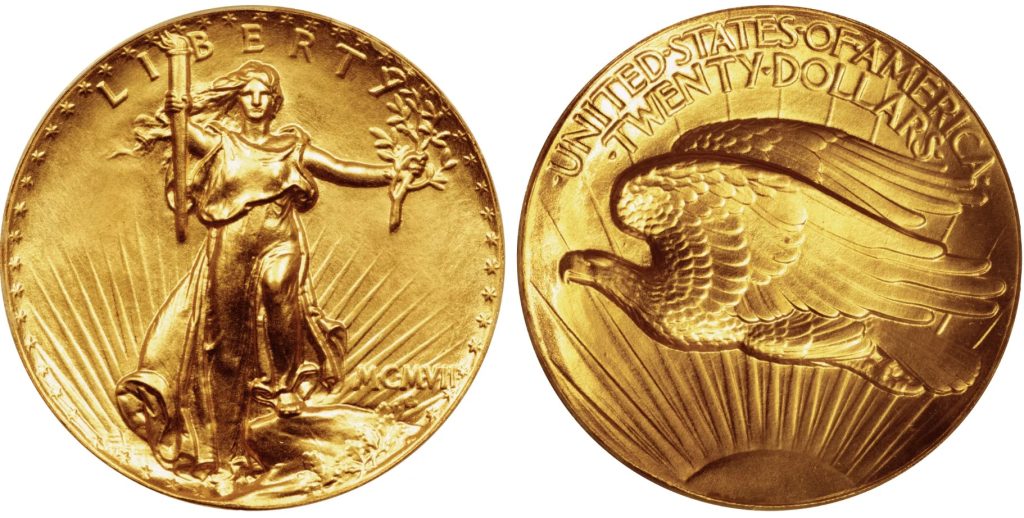
PROOF GOLD COINS
Proof coins are a limited number of coins produced by a mint to check the dies. U.S. mints began producing proof coins in 1820. In some years only 100 proofs were produced. They can be identified by their shiny surfaces and sharp crisp details and edges. Proof coins are rare and valuable, and coveted by collectors. Due to their limited mintage and the steady appetite of new collectors, the values for the early gold proofs has only increased. One of the more valuable proof coins is the 1907 Saint-Gaudens Gold Double Eagle Ultra High Relief. Then President Theodore Roosevelt had ordered the coin to be re-designed where the relief decoration would be much higher than usual. The mint attempted the high relief; however, the process was complicated and ultimately it was deemed not efficient for mass production. The design was eventually lowered, but in the short term a few ultra-high relief proof coins were produced. These proofs consistently sell above $2 million at auction, with the finest examples selling close to $3 million.
Serious numismatic collectors and investors tend to focus on these three collecting areas due to the significant rarity and the long-term investment that goes with that. With a fixed and limited supply of these early minted coins and demand ever increasing, the investment opportunity is solid and established.
FURTHER READING
- Insider Look at Fine Art, Wine & Trading Cards
- Art & Collectibles: The Rise of Alternative Investments
THE STATE OF THE ART MARKET: SPRING 2019
2018 was a very busy year for both auction houses and the private sector, with global art market sales reaching $67.4 billion up 6% year-on-year.[1] Auction houses and larger galleries are prospering in this market, leaving smaller and mid-sized galleries behind and increasing the disparity between these large and small organizations. Fewer galleries are opening and more are closing as bigger gallery names consolidate both artists and clients.[2] Museums and dealers alike are focusing their attention on diversity and inclusion, highlighting artists of color and women who are experiencing increased exposure in exhibitions leading to an increase in market demand. 2018 was a record year in terms of sales volume and Postwar and Contemporary art remained the leader, followed by Impressionist and Modern. [3]
The art market is not protected from uncertainty and functions like other big markets. In 2016, all major markets declined due to economic and political uncertainties damaging market confidence, with sales losing 16% of their value in the years 2014 to 2016.[4] By 2017, the environment of the market improved for sales with stronger consumer confidence and increased supply at the top of the market. The market realized a powerful and positive gain of 12% in 2017 with the auction sector outperforming the dealer sector. While the mood of the art market in 2018 was slightly less hopeful due to larger economic and political issues impacting investor and consumer attitudes, it did not stop people from buying. More risk-averse buyers and sellers moved into private sales within the dealer market, which experienced a 7% growth in 2018. The auction market advanced by 3%, and there was additional e-commerce growth. [5]
The majority of growth at auction continued to be focused on the top end of the market, leaving the middle and lower segments to be stagnant or declining, a trend reflected in the dealer market as well. In 2018, sales in the auction segment (including both public and private sales auction houses, both on- and offline) constituted 46% of the market, down 1% year-on-year. The dealer segment (including dealer, gallery, and online-only retail sales) made up the remaining 54% of the market.[6] Sales at public auction of fine and decorative art and antiques (excluding auction house private sales) reached $29.1 billion in 2018, an increase of 3% year-on-year, and up nearly 30% over 2016; dealer sales in 2018 reached an estimated $35.9 billion, up 7% year-on-year.[7] The global art market continues to be dominated by the US, UK and China, with their combined sales accounting for 84% of the global market’s total value.
The art world continues to be globalized, bringing in more success for auction houses and larger galleries alike, impacted greatly by technology. Increased integration between technology and the art world has led to a greater flow of information globally, allowing buyers to access images and information on works instantly. Technology is actively influencing how buyers are making decisions and is even going so far as to impact art-making with AI. This has led to the increased importance of online sales; in 2018, global sales in the online art and antiques market reached an estimated $6 billion, up 11% year-on-year.[8]
In 2018, art fairs continued to be a crucial aspect of global art sales and act as a central part of the livelihoods of many dealers. There were around 300 fairs with an international element in 2018, and art fair sales were estimated to have reached $16.5 billion in 2018, a rise of 6% year-on-year. [9]
Over the past decade, sales have generally reached a much higher level making it increasingly hard to establish and maintain continued high levels of growth, especially when coupled with a supply-limited art market. The volume of sales as measured by the number of transactions increased at a slower rate compared to values, growing only 2% year-on-year. The number of transactions reached its highest level since 2008 at an estimated 39.8 million, led primarily by increased sales by dealers in the online sector with fine art auction declining slightly for the second consecutive year. [10]
SEGMENT TRENDS
Contemporary art continues to dominate with booming sales and growth across the board.[11]
Post-War and Contemporary art was the largest sector of the fine art auction market in 2018, accounting for 50% by value and 47% by volume. Reaching sales of $7.2 billion, Post-War and Contemporary art realized an increase of 16% year-on-year, despite a minimal drop in the number of lots sold by 5%.[12] Currently, the Contemporary market is experiencing a big push for both artists of color and female artists. These underrepresented groups are gaining more attention, and specifically there is a growing interest in abstract expressionist female painters. In 2018 the US remained the global center for Post-War and Contemporary art. Looking East, China maintained its spot in second place. The growing Asian market for Post-War and Contemporary art recently has focused on younger, contemporary artists such as Banksy, Kaws, and Jonas Woods. Furthermore, globally, there has been a revival of interest in established artists from the 1960s and 1970s, with more inclusion of female artists and artists of color. Following another strong year of growth in 2018, the value of Post-War and Contemporary art increased by 63% in the past decade from 2008 to 2018.
After Contemporary sales are Impressionist and Modern sales. Behind the Contemporary sector, in 2018 the Modern art sector was the second largest in the global fine art market with a share of 29% by value and 31% by volume. Following two years of strong growth, in 2018 Modern art sales were $4.3 billion despite a decline of 10% in the volume of transactions. [13] Demand for Picasso paintings from the 1960s is as high as ever, as is interest in key members of the Surrealist group, in particular René Magritte and Joan Miro. Behind Modern art is the Impressionist and Post-Impressionist market, a sector which has had mixed performance over the past decade. The sector had a share by value at 15% in 2018, a slight decrease from 17% in 2017. The Impressionist and Post-Impressionist sector constituted 14% of the share in the number of global fine art lots sold at auction.[14]
The smallest of all the sectors in the global art market is Older Master and European Old Masters. Accounting for 6% share of the value of the fine art auction market in 2018 (down 3% from 2017), Old Masters made up 8% of the number of transactions in the fine art auction market. In 2018, the sales of all Old Masters works fell right below $905 million, a 31% decline in value year-on-year. This decline can be partially attributed to the outlier lot in 2017. The sector’s market has declined over the last 10 years, with values at their lowest point after falling 9% since 2008.
FURTHER READING
- State of the Art Market: Insights Into the Spring 2022 Auction Season
- Looking Forward: Ten Art Market Predictions for 2023
- Spring Art Market Recap 2022
Bickar, Betsy. State of the Art Market: Spring 2019. Report no. Spring 2019. April 17, 2019. Accessed July 23, 2019. https://www.privatebank.citibank.com/pdf/State-of-the-Art-Market-Spring-2019.pdf.
McAndrew, Clare, Dr. The Art Market 2019. Report no. 3. Accessed July 23, 2019. https://www.ubs.com/global/en/about_ubs/art/2019/art-basel.html.
[1] McAndrew, Clare, Dr. The Art Market 2019. Report no. 3. Accessed July 23, 2019. https://www.ubs.com/global/en/about_ubs/art/2019/art-basel.html.
[2] Bickar, Betsy. State of the Art Market: Spring 2019. Report no. Spring 2019. April 17, 2019. Accessed July 23, 2019. https://www.privatebank.citibank.com/pdf/State-of-the-Art-Market-Spring-2019.pdf.
[3] Ibid.
[4] McAndrew, The Art Market 2019. Report no. 3.
[5] Ibid.
[6] Ibid.
[7] Ibid.
[8] Ibid.
[9] Ibid.
[10] Ibid.
[11] Bickar, State of the Art Market: Spring 2019. Report no. Spring 2019.
[12] McAndrew, The Art Market 2019. Report no. 3.
[13] Ibid.
[14] Ibid.
We are delighted to announce that we assisted our clients with the sale of the below works at the British & European Art: Victorian, Pre-Raphaelite & British Impressionist Art on 11 July 2019 at Christie’s London.
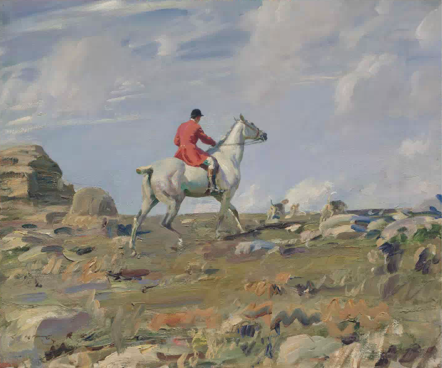
Sir Alfred James Munnings
Ned Osborne on ‘Grey Tick’, Zennor Hill, Cornwall
Oil on canvas
25 x 30 in.
Signed ‘A.J. MUNNINGS’ (lower left)
PROVENANCE
with G. Blair Laing, Toronto, 1958, where purchased by the grandfather of the present owners.
EXHIBITION HISTORY
London, Alpine Gallery, Pictures of the Belvoir Hunt and Other Scenes of English Country Life by Alfred J. Munnings, R.A., 1921, no. 40, as Zennor Hill, Cornwall.
LITERATURE
The Field, 21 April 1921, p. 625, as Zennor Hill, Cornwall.
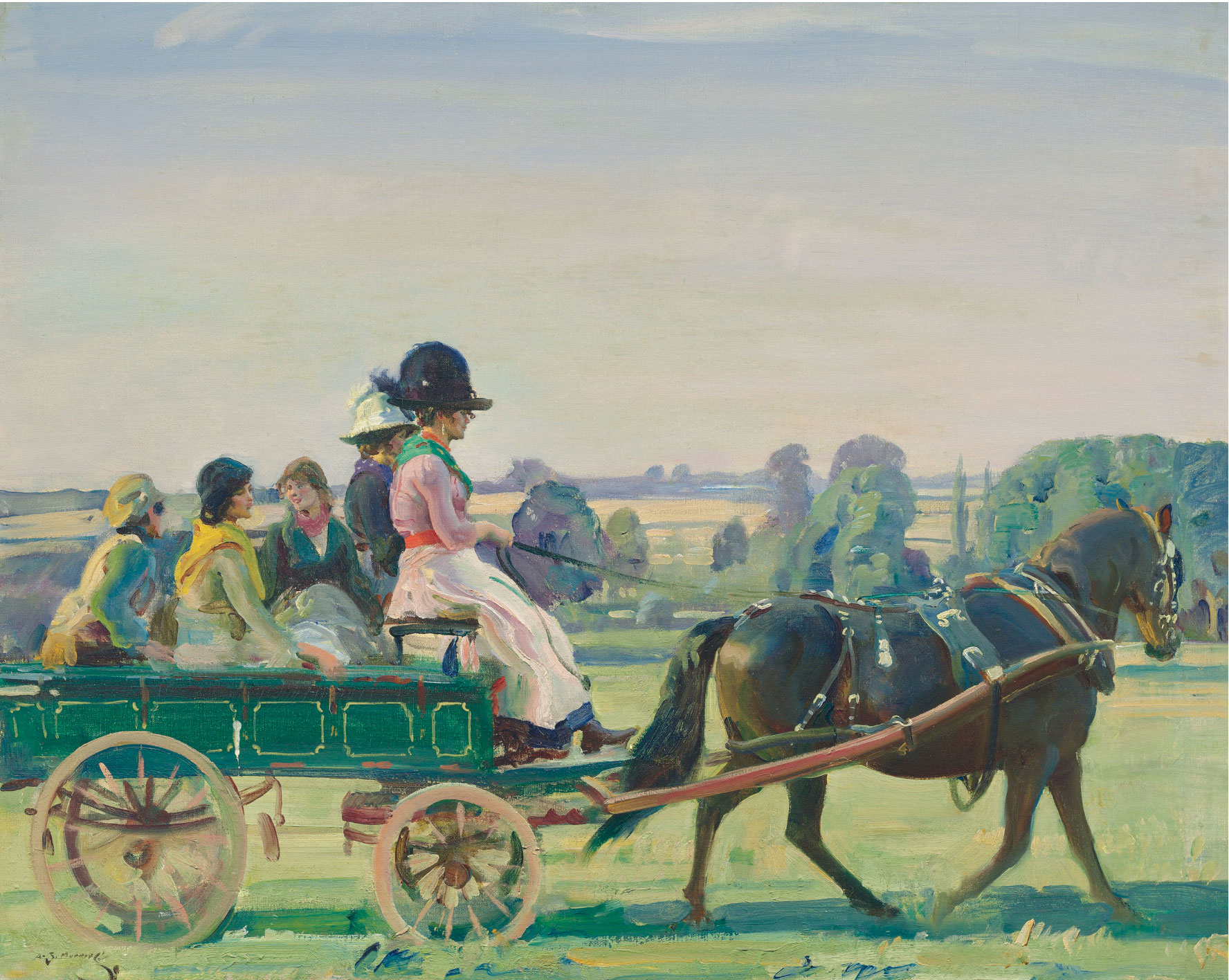
Sir Alfred James Munnings
The Green Waggon
Oil on canvas
25 x 31 in.
Signed ‘A.J. MUNNINGS’ (lower left) and further signed and inscribed
“The Green Waggon”/Alfred. J. Munnings,/Castle House,/Dedham E.’
(on a “War Service” economy label attached to the stretcher)
PROVENANCE
with G. Blair Laing, Toronto, 1958, where purchased by the present owner.
EXHIBITION HISTORY
London, Royal Academy, 1921, no. 554.
Liverpool, Walker Art Gallery, Autumn Exhibition, 1921, no. 937.
LITERATURE
Royal Academy Illustrated, London, 1921, p. 100, illustrated.
The Children’s Newspaper, 21 May 1921, p. 3.
Sir A.J. Munnings, The Second
OUR SERVICES
Offering expert Advisory across sectors, our dedicated Advisory and Sales Agency teams combine strategic insight with transparent advice to guide our clients seamlessly through the market. We always welcome the opportunity to discuss our strategies and services in depth.
Let Our Advisors Assist You this Father’s Day
Let The Fine Art Group assist you with finding the perfect gift for Father’s Day. Our Art Advisory team reviews art fairs and all major auction and dealer catalogues. We are positioned to be able to source the rare and unique, whether it be jewelry, fine art, wine, rare books or other decorative arts.
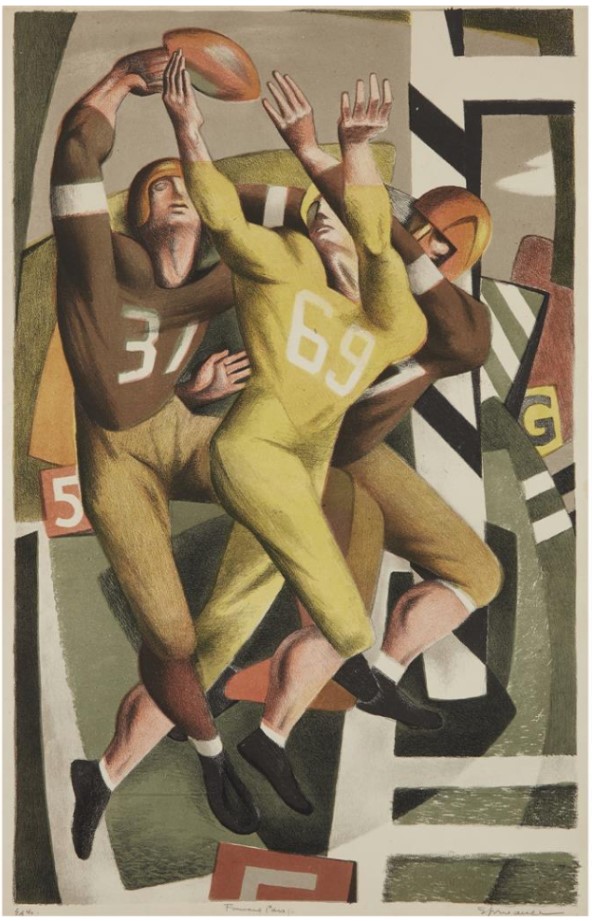
American Art & Pennsylvania Impressionists
June 9, 2019
Benton Murdoch Spruance (1904–1967)
Forward Pass
1944
Edition of 40.
Pencil signed ‘Spruance’ bottom right; also titled bottom center and inscribed ‘Ed. 40’ bottom left
Color lithograph (with five colors) on paper
Image size: 20 1/16 x 12 1/2 in.
Sheet size: 23 x 15 5/8 in.
Printed by Cuno.
[Fine/Looney 231]
Estimate $3,000-5,000
PROVENANCE
Private Collection, Philadelphia, Pennsylvania.

Exclusive Watches Sale
June 6, 2019
Rolex
GMT-Master Ref. 1675 in Steel
1967
Ref: 1675
Case Number: 1830596
Case Material: Stainless steel
Case Dimensions: 40 mm in diameter
Dial: Black with luminous hour markers, date aperture at the “3” hour marker
Bracelet Material: Rolex signed ref. 78360 in stainless steel
Bracelet Size: 6 3/4 in.
Movement: Automatic
Functions: Time, date, GMT
Caliber: 1575
Estimate: $5,000
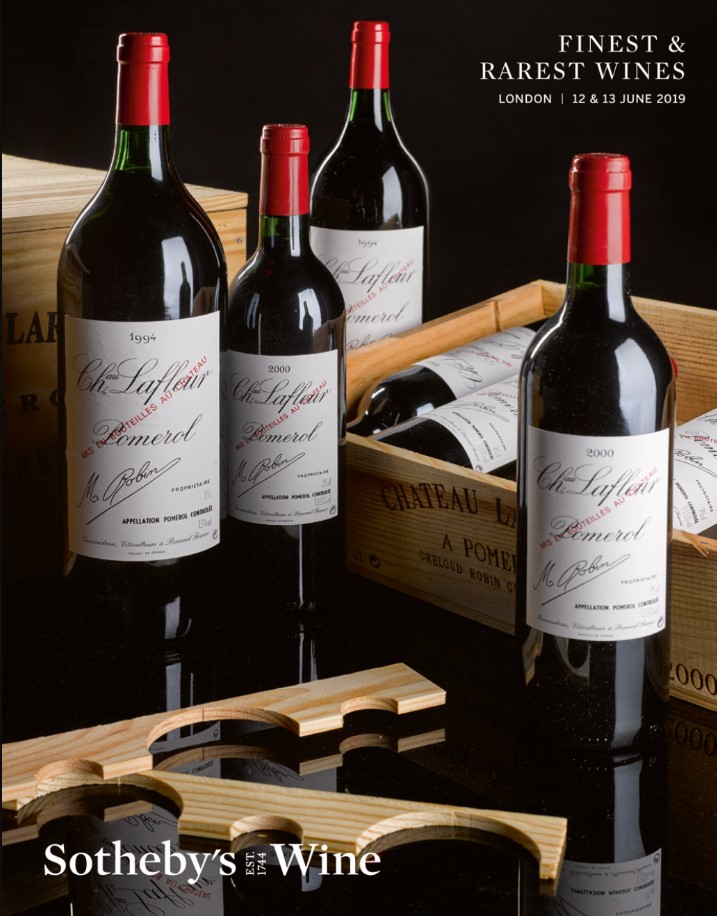
Finest & Rarest Wines Sale
Petrus 1992, Pomerol
Excellent levels and appearance, WA 90, 8:5 bts (owc)
Estimate Per Lot: $6,500-$8,000

Fine Books and Manuscripts
June 13, 2019
John Fitzgerald Kennedy (1917-1963)
Profiles in Courage
New York: Harper & Brothers, 1961.
Estimate: $2,000-$3,000

The David Gilmour Guitar Collection
Lot 6
Gibson Guitars
GIBSON INCORPORATED, KALAMAZOO,
1973
A Solid-Body Electric Guitar, Les Paul
Estimate: $2,500-$3,500
NOTE
Orville Gibson, who in 1894 worked as a part-time shoe salesman and restaurant clerk in Kalamazoo, Michigan, possessed a dual passion for music and woodworking. Although Gibson lacked any formal training as a luthier, it was his creative thinking, at the nexus of these two passions, which convinced him that he had the means to greatly improve guitar construction.
OUR SERVICES
Offering expert Advisory across sectors, our dedicated Advisory and Sales Agency teams combine strategic insight with transparent advice to guide our clients seamlessly through the market. We always welcome the opportunity to discuss our strategies and services in depth.
COLLABORATION WITH INTERIOR DESIGNER PATRICK SUTTON
Our art advisory team is honored to work with Patrick Sutton. Patrick is an international acclaimed interior designer and story teller whose interiors convey a sense of refined luxury.
“Baltimore-based interior designer Patrick Sutton grew up touring the world with his travel journalist father and fashion model mother. The golden light of Rome, the colorful spices of Marrakesh, the polished marble floors of a Paris hotel: the young voyager developed a vivid visual library of the world’s beautiful spaces. Following his love of design to a career in architecture and interiors, Sutton today draws upon this store of memories to craft unique designs intimately related to his clients and their dreams.”
The Fine Art Group congratulates Patrick on the publication of his first book Storied Interiors which focuses on high end residential interiors as well as public spaces such as the Sagamore Pendry Hotel in Baltimore, MD which was recently rated as the Number One Hotel in North America by Condé Nast.
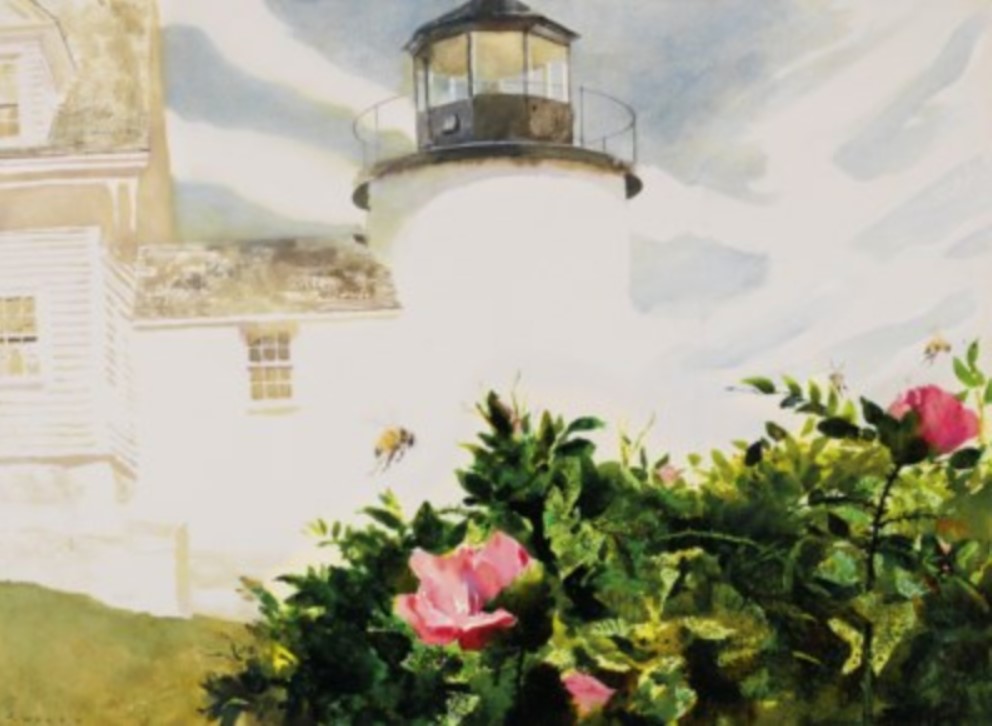
Christie’s
Sale 17034
Lot 54
Jamie Wyeth
Rosa Rugosa
Watercolor and pencil on paper
20 ½ x 28 in.
Sold: $137,500 (with Buyer’s Premium)
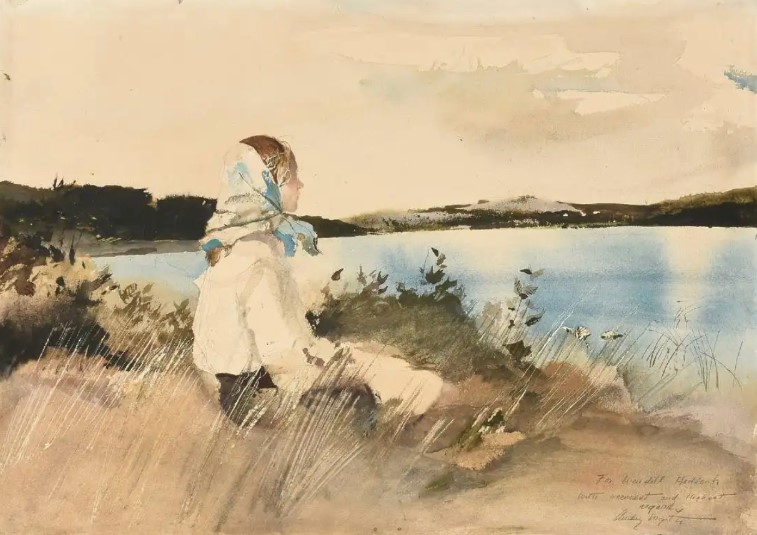
Andrew Newell Wyeth
Jean Hadlock
Watercolor on paper
15 x 21 in.
Sold: $170,000
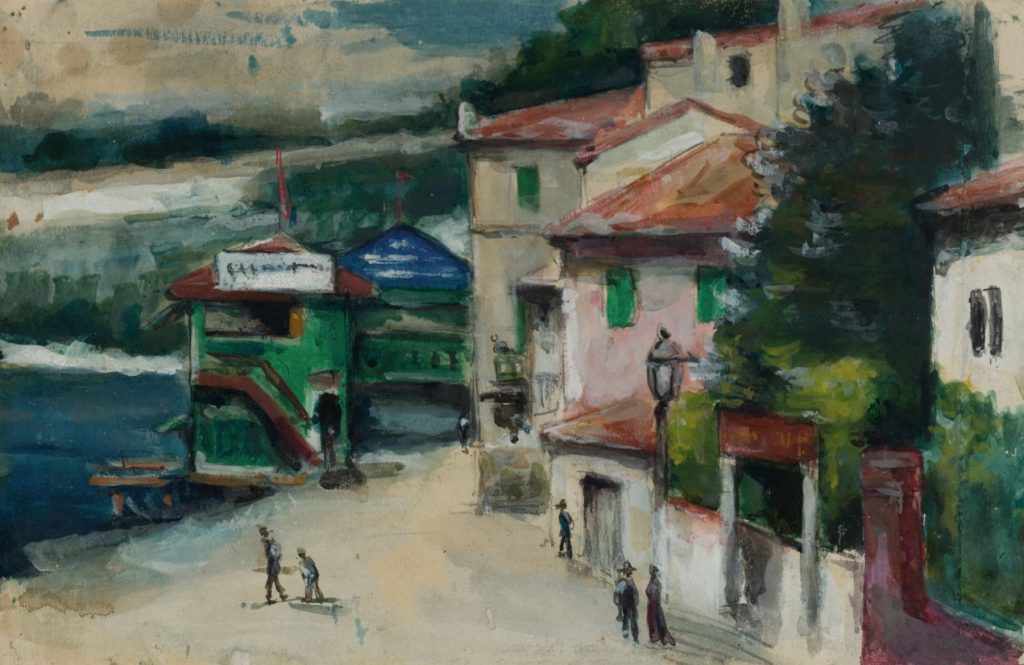
Sotheby’s
Impressionist & Modern Art Day Sale
Paul Cézanne
Le Restaural Mistal à L’Estaque
Gouache, watercolor and pencil on paper
9 x 14 in.
Sold: $225,000 (with Buyer’s Premium)

Christie’s
Sale 17156
Lot 486
André Brasilier
Vert printemps
Oil on canvas
21 ¾ x 18 1/8 in.
Sold: $50,000
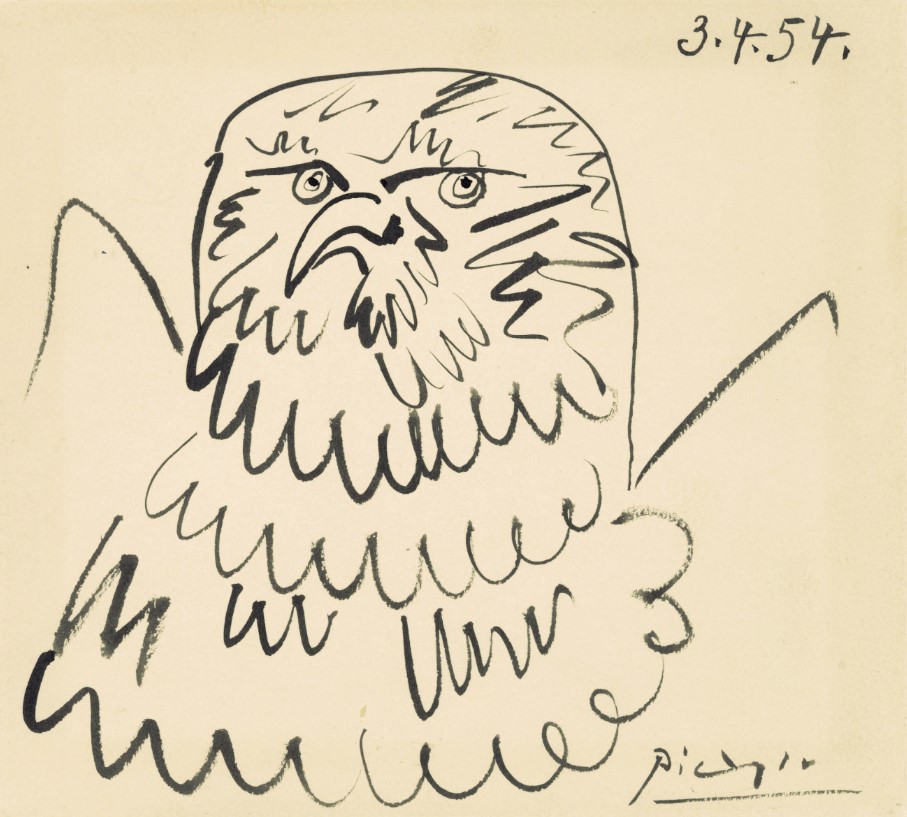
Christie’s
Sale 17155
Lot 197
Pablo Picasso
Chouette
India ink on paper
7 x 8 in.
Sold: $68,750 (with Buyer’s Premium)
Bonhams
Lot 141
Joseph Henry Sharp
Indian Encampment at Sunset
Oil on canvas laid down on board
5 x 7 in.
Sold: $10,075 (with Buyer’s Premium)
Christie’s, Sale 17163
Andy Warhol, Sunset Series

Andy Warhol
Sunset
Unique screenprint in colors
34 x 34 in.
Sold: $87,500 (with Buyer’s Premium)
Andy Warhol
Sunset
Unique screenprint in colors
34 x 34 in.
Sold: $93,750 (with Buyer’s Premium)

Andy Warhol
Sunset
Unique screenprint in colors
34 x 34 in.
Sold: $75,000 (with Buyer’s Premium)
Andy Warhol
Sunset
Unique screenprint in colors
34 x 34 in.
Sold: $68,750 (with Buyer’s Premium)
OUR SERVICES
Offering expert Advisory across sectors, our dedicated Advisory and Sales Agency teams combine strategic insight with transparent advice to guide our clients seamlessly through the market. We always welcome the opportunity to discuss our strategies and services in depth.
Have you recently inherited a piece of jewelry or art that is not yet insured? It’s also possible that the worth of a valuable you own has increased over the years without your knowledge, and it’s no longer adequately protected by your policy.
I cannot stress enough that appraising your valuables is critical for securing adequate insurance. But how do you go about having the appraisal done? Read my interview with Colleen Boyle of The Fine Art Group below. With over 20 years of experience in the art and financial world, she shares her views on the importance of appraising your valuables to secure adequate insurance coverage and how to find a qualified appraiser.
Q & A WITH COLLEEN BOYLE
WHY IS THE APPRAISAL OF ANY VALUABLE IMPORTANT?
Having adequate insurance coverage—An appraisal process will help you identify what you own, know the value, and document your valuables in the form of either a visual inventory (photographs/videos), a written report, or a combination of both. This is extremely helpful, if not a must, to adjust your existing contents coverage within your Homeowners policy or to select sufficient insurance coverage for all your items so you can be made whole should a loss occur.
To demonstrate my point, here’s an example. The Fine Art Group conducted an appraisal for a client of mine who had a total contents coverage at $250,000. As a result of the evaluation, we discovered they had a little less than $1 million worth of books and manuscripts—they had absolutely no idea they were worth that amount of money. They scheduled some of the valuables on their insurance policy, and they also increased their contents coverage on their Homeowners’ policy to cover all the other items in their house (furniture, decorative items, etc.). Approximately a year and a half later, that client had an electrical fire. Because they had proper visual and written documentation of all of their lost valuables, it helped make the claims process more efficient, and they were reimbursed for everything they had lost in the fire.
HOW DO YOU SELECT THE RIGHT APPRAISER?
Work with your insurance advisor to select an appraiser that fits your needs; your advisor might even already have a trusted relationship with a reputable appraiser. This relationship will provide you with more comprehensive protection all around, because it takes both a proper appraisal and a strong policy to protect your valuables. When your insurance and appraiser professionals work together closely, they are more likely to catch gaps in coverage and value changes.
For instance, a client of mine wanted to make sure their Andy Warhol screen print scheduled on their insurance for $22,000 was protected during their move. The Fine Art Group reviewed the schedule, and it turned out the piece was actually worth over $200,000. We recommended that the piece be revalued at the current retail replacement value, and we worked with the insurance advisor to have the client’s current policy changed to reflect the correct value so that it would be protected during transportation.
WHAT QUALIFICATIONS SHOULD A GOOD APPRAISER HAVE?
Here are six selection criteria to consider:
- Industry recognition: I highly recommend selecting an appraiser who is a member of at least one of the three industry associations (Appraisers Association of America, International Society of Appraisers, and American Society of Appraisers). These associations have strict criteria for accepting new members, and they require annual continuing education to keep current.
- Certification: A good appraiser should also stay up-to-date on their USPAP—an exam taken every other year that keeps appraisers current on tax law changes, updates in IRS appraisal requirements, and insurance market developments.
- Specialized expertise: Many appraisers don’t have deep expertise in every valuable you might have. But, it behooves you to find an appraiser who specializes in knowledge of multiple valuables (jewelry, art, antiques, wine collection, sports memorabilia) so you are receiving an accurate evaluation and recommendations for protecting all of your different assets.
- Security: If an appraiser is coming to your home, would you be concerned with your privacy and security? Only a few companies address this concern. For instance, at The Fine Art Group we conduct background checks on our appraisers, and we also send a bio and a photograph of the appraiser to you prior to the appointment. This is not a standard process, so be sure to select an appraisal company that makes you feel comfortable.
- Confidentiality: Although non-disclosure agreements are important for people who are concerned with confidentiality, they are not offered by all appraisal companies. Make sure to work with an appraiser that ensures your information won’t be shared with anyone, including attorneys, wealth advisors, and fellow coworkers, without your express permission.
- Fiduciary and advocate: Appraising is more than just a transaction. A good appraiser serves in a fiduciary role protecting your best interests when providing guidance on handling your valuables and ensuring you have proper insurance coverage. For example, at The Fine Art Group we protected the interests of one of our clients by identifying the best international auction house where their artwork would sell for the most money (which was overseas), and then also helped ship the piece.
If you have any questions about selecting the right appraiser or evaluating and insuring your valuables, contact me at john@psafinancial.com.
ABOUT THE AUTHOR
Joining PSA in 1981, John Lannon, vice president, is the longest tenured account executive, with 34 years of service and is consistently ranked as a leading personal lines broker at PSA. John was instrumental in launching PSA’s Private Client Group, catering to the affluent market, bringing together the elite insurance carriers in the industry for the implementation in regional, national, and worldwide scenarios.
Read the entire article at Personal Insurance.
UPCOMING AUCTION SALES FOR MOTHER’S DAY GIFTING
Let a Fine Art Group Advisor assist you with finding the perfect gift for Mother’s Day.
The Fine Art Group team reviews art fairs and all major auction and dealer catalogues. We are positioned to be able to source the rare and unique, whether it be jewelry, fine art, wine, rare books or other decorative arts.

Freeman’s – Jewelry & Watches
Lot 159
Cartier
An eighteen-karat gold, turquoise, and cultured pearl bracelet, Cartier Inc.
rope twist design set with 5.4mm cultured pearls and turquoise beads with gold rope.
Length: 7 1/4 in.
Estimate: $6,000-$8,000
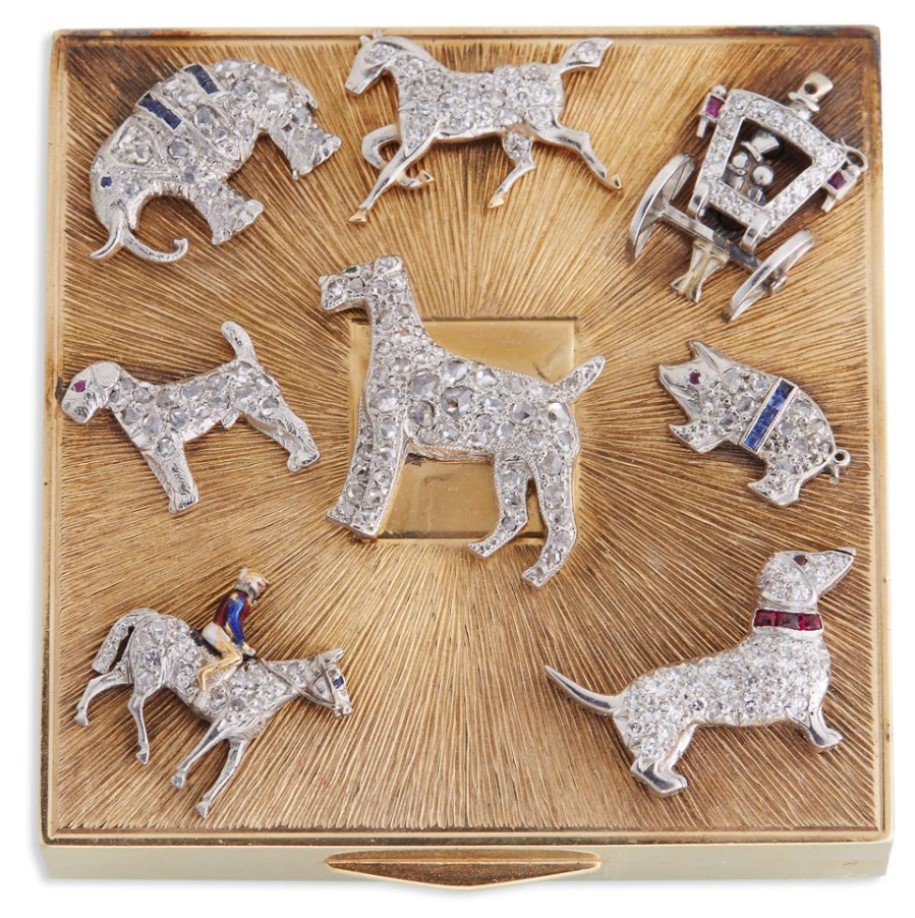
Freeman’s – Jewelry & Watches
Lot 29
A gold compact with eight platinum and diamond charms
square compact with textured gold and eight applied platinum and diamond charms designed as a carriage, scottie dogs, equestrian, and other animals.
52.8 dwt.
Length: 2 1/4 in.; Width: 2 1/8 in.
Estimate: $4,000-$6,000

Swann Auction – Contemporary Art
Sale 2509, Lot 177
Andy Warhol
Letter to the World (The Kick)
Color screenprint on Lenox Museum Board, 1986. 905×905 mm; 35 5/8×35 5/8 inches (sheet), full margins. Edition of 100. Signed and numbered 75/100 in pencil, verso (the two zeros effaced). With the Andy Warhol Art Authentication ink stamp and annotation “A126.066” in pencil, verso. Printed by Rupert Jasen Smith, New York. Published by Martha Graham Center of Contemporary Dance, Inc., New York. From Martha Graham. A very good impression with strong colors. Feldman 389.
Estimate: $25,000-$35,000

Swann’s Literature
Lot 121
F. Scott Fitzgerald
Tender is the Night
New York: Scribner’s, 1934. First Edition, first printing
Estimate: $3,000-$4,000
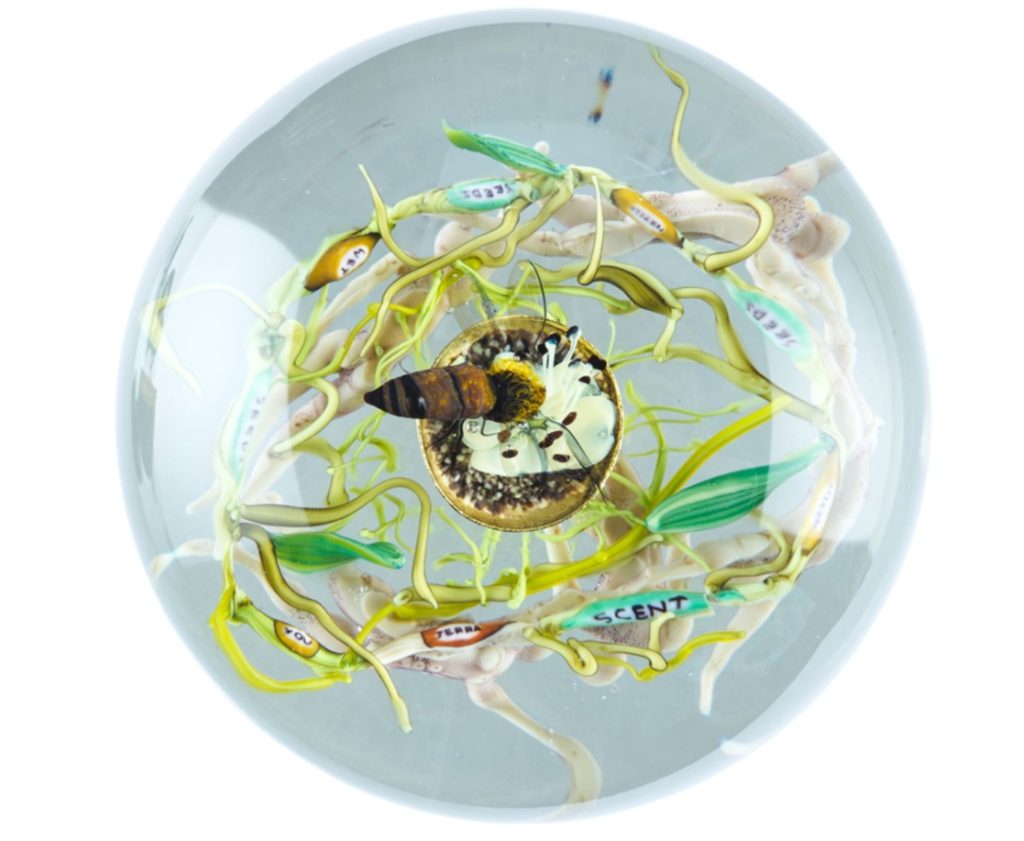
Rago’s Modern Ceramics and Glass
Lot 121
Paul Stankard
Paperweight with root people, bee, flower, and word canes
Millville, NJ
1995
Lampworked glass, polished clear glass
Etched signature, date/H16
Estimate: $1,000-$1,500
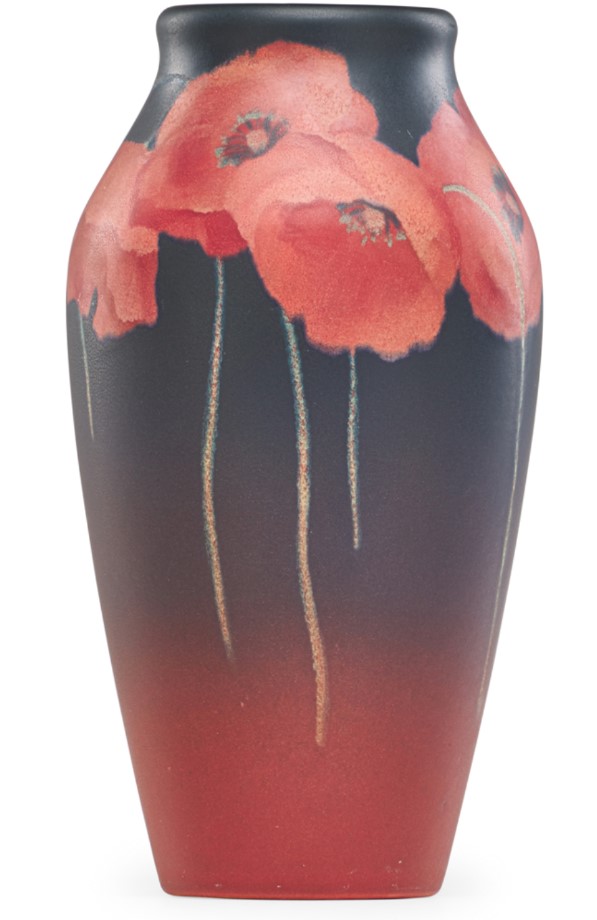
Rago’s Modern Ceramics and Glass
Lot 121
Harriot Wilcox for Rookwood
Exceptional Painted Mat vase with poppies (uncrazed), Cincinnati, OH, 1902 Flame mark/II/192CZ/H.E.W.10″ x 5 1/2″The companion piece to this vase is in the permanent collection of the Metropolitan Museum of Art, New York.
Estimate: $2,000-$3,000
A TANGIBLE ASSET FIDUCIARY PROTECTS COLLECTORS
It was 4:00 am in Houston when my cell phone made that annoying “ping” alerting me to an incoming email. From a dazed and former deep sleep, I reached for my phone and saw that an “advisor” had sent me a painting apparently for sale that he thought I would be interested in for our clients. It had all the trappings of a scary deal: a work of art that was too good to be sending on an email, a price that was too high and did not reflect the market, and a source that I knew was hoping to make some quick money. I deleted the message, as I do every time.
That little email that jolted me from my peaceful sleep got me to thinking about what I wanted to share in the talk I was giving that morning in Houston to a group of highly intelligent business men and women who were interested in buying and selling with intelligence.
Tangible Asset Fiduciary. The term does not exist in the dictionary and you won’t study it when you are becoming an appraiser and certainly not when you are learning the skills as an art advisor. Hundreds of clients look to The Fine Art Group to serve as their tangible asset fiduciary when they decide to monetize their collections. A tangible asset fiduciary is a “fire wall” between the client and the auction house, dealer or art advisor. As a representative of the seller, our client, we ensure that the sale process works and that the work of art is with the best venue and all the steps for a successful sale are being met. Honestly, it is a mistake to try to go it alone when you are selling at auction.
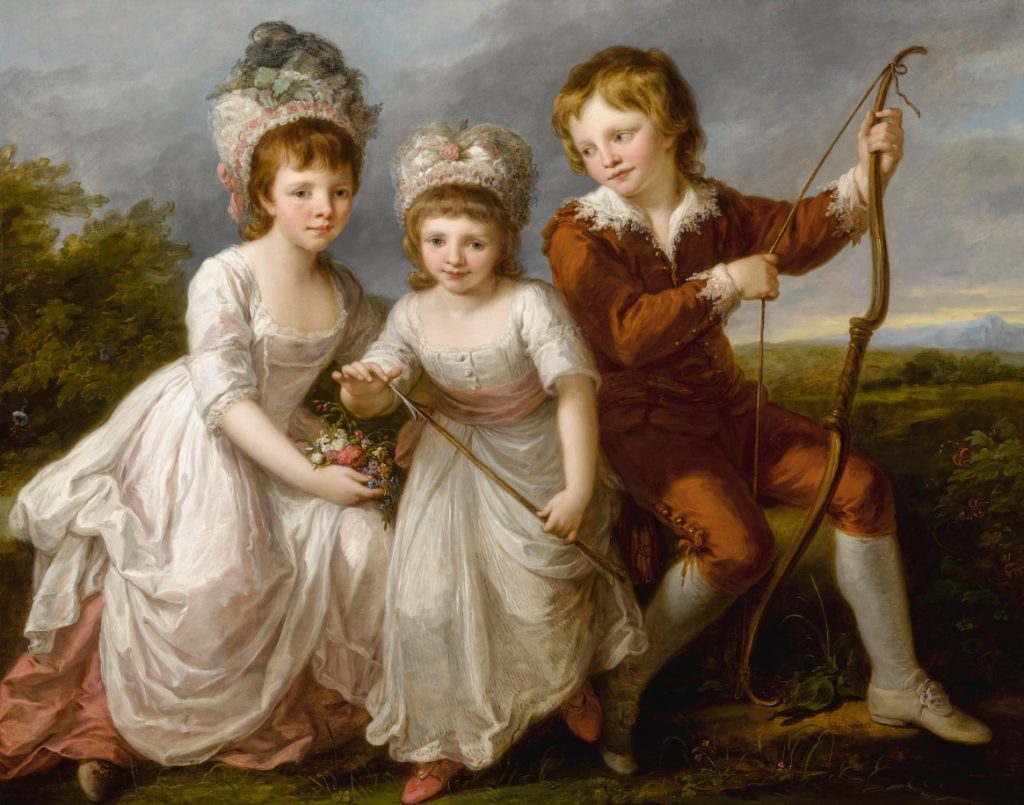
It is imperative that each of the following steps are taken to ensure a good result at auction.
1. Find the right auction house. Kerry Jeffrey, our Director of Consignments, clearly articulated this point in her article on finding the right venue. To find the correct venue our team looks at how many works of art by that artist the auction house has sold successfully in the past. For example, we are currently evaluating the best venue for a significant sporting artist. We want to see how many works have sold in the last four years for this artist at each of the venues we are exploring for sale.
2. Negotiate the terms. It is important to understand that the auction business is expense heavy. Auction houses need to insure the works while in storage, they need to produce expensive catalogues, they need to pay for expensive real estate and they need to pay their expert staff. Therefore, due to the high cost of doing business, they will try to look to the seller to absorb some of those costs. The auction house can charge for photography fees, insurance fees, storage fees, shipping fees, buy in fees, sellers commission, and marketing fees. However, all of these fees can be waived if the collection has value.
3. Understand the nature of the sale. Deciding on the correct auction houses and negotiating the fees is just the first step in ensuring a successful outcome in a sale. Now comes the important part of the negotiation. You do not want your piece to be in a sale which is already top heavy with your artist. In addition, you want to make sure your work is not the last of the five-other works by the same artist.
4. Negotiate the marketing of your collection. If your work is of high quality or value, you should ensure that the work is featured in press, in a predominant place in the catalogue and in the internal auction marketing campaigns. A high price achieved at auction happens if people are aware of your work of art. High exposure is essential.
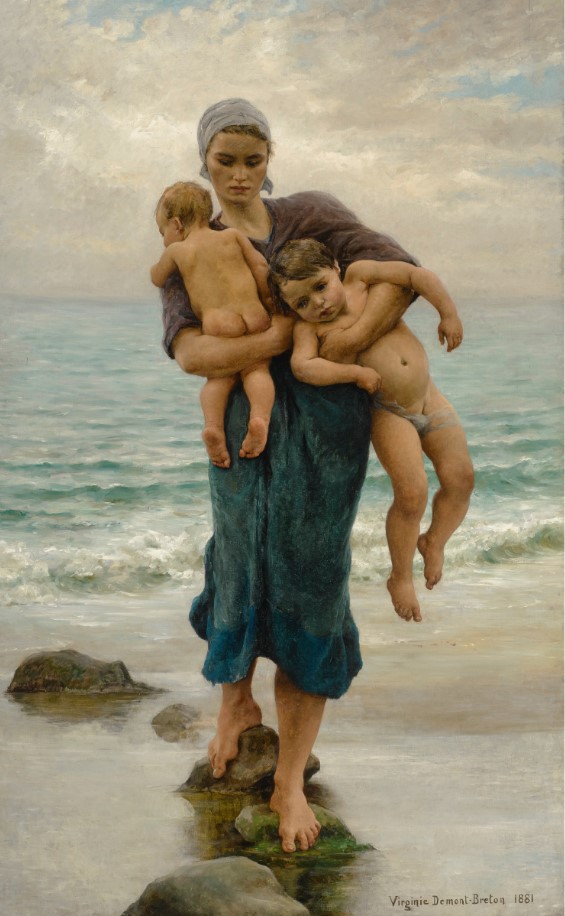
5. Estimates are the Secret Sauce to a Successful Sale. I know it seems illogical to place estimates that appear to be below the “value” of the work. However, in order for auctions to work you need a minimum of two people to want the work of art. Preferably you want 10 people who want your work and you want them to be bidding on line, standing in the auction room and calling on the phone. If you place lower estimates on the pieces, you have a much better chance at a higher return. The psychology of auction require emotion.
6. Don’t forget the guarantee. If you have a very significant work of art, you may benefit from an auction guarantee. It is not always in your financial interest, but it can provide you with a safety net.
7. Insure your collection when it is in transport. The biggest losses tend to occur when your art work leaves your house and is transported to the auction house. You want to ensure you have a true insurance value on the pieces so that in case of loss you are made whole again with a check that represents the value of the piece. Don’t trust the shippers to have appropriate insurance. If your artworks are currently with a “direct insurer” and you have valuable paintings, jewelry or collectables, consider working with a risk advisor who will place you with the best insurer for your needs. The Fine Art Group can help you find a professional insurance broker.

8. Reserves. The reserve is the lowest number in which you are willing to sell your work. The reserves are not known to the public but should be set as close to the sale date as possible. There is a lot of information that comes into the auction house very close to the sale which will provide insight into buyer interest in the piece. It is important that you make sure your reserve is low enough that an auctioneer has the ability to start low to get people excited about bidding on the piece.
9. Placement in the Auction Show Room. Make sure that when the exhibition is up for viewers of the sale, that your work is displayed in a dominant position in the sale room and has good light.
10. Avoid having the work of art go unsold. An unsold work of art is not good for its resale value. If you abide by the first 9 steps, you should have a successful sale and avoid getting the object back.
Don’t do it alone. Allow your tangible asset fiduciary to bring their expertise to the successful sale of your work of art or collection.


